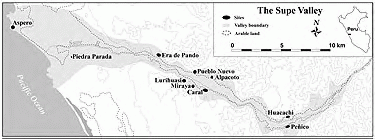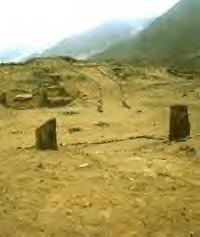|
|
Canku Ota |
|
|
(Many Paths) |
||
|
An Online Newsletter Celebrating Native America |
||
|
May 5, 2001 - Issue 35 |
||
|
|
||
|
Artifacts Reveal Age of Ancient City |
||
|
by Ruth Shady, Winifred Creamer and Jonathan Haas |
||
|
Photos by Jonathan Haas; Courtesy of The Field Museum, Chicago |
| The ancient Peruvian site of Caral may have been one of the first urban centers in the
Americas, thriving more than a thousand years before other known cities, according to a study in the 27 April issue
of the international journal, Science. New radiocarbon dates indicate that Caral's immense stone structures were built between 2600 and 2000 B.C. This inland metropolis is therefore roughly the same age as smaller maritime-based societies on the coast, previously thought to preceed more complex societies. "What we're learning from Caral is going to rewrite the way we think about the development of early Andean civilization," said Science author Jonathan Haas, of the Field Museum in Chicago. |
|
| Given the scale of architectural and agricultural development in Caral, he added, early urban planners were power players. | |
| "The size of a structure is really an indication of power," said Haas. "It
means that leaders of the society were able to get their followers to do lots of work. People don't just say 'hey,
let's built a great big monument,' they do it because they're told to and because the consequences of not doing
so are significant." Caral is one of 18 sites in the Supe valley of central Peru, which all have "monumental" architecture, meaning larger than house-size. Such structures are typically associated with civilizations younger than 1500 B.C. Archeologists discovered Caral in 1905, but have not known its age until now. |
|
| Haas and his colleagues, Winifred Creamer of Northern Illinois University, and Ruth Shady Solis of the Universidad Nacional Mayor de San Marcos, in Lima, used radiocarbon dating to determine the ages of reed fibers from shicra bags found at Caral. ("Shicra" is the indigenous word for "woven.") Because the reeds live for only one year, the dates were extremely specific. | |
| Workers used the bags to carry rocks for building enormous structures called platform
mounds, which were partly ceremonial and partly residential for high-status citizens. Instead of reusing the bags,
workers placed them, rocks and all, inside the structures' retaining walls. The Supe Valley stretches eastward from the Pacific coastline, up the slopes of the Andes. Caral has some of the largest buildings of the valley's sites; the largest platform mound is approximately the length of two football fields, nearly as wide, and five stories high. |
|
| The site also has a variety of apartment-like buildings, whose residential nature was
revealed by the trash found inside, and others that may have served ceremonial or administrative purposes. Some
of these structures, such as the two sunken circular plazas in the central zone of the site, are also found frequently
at younger sites in South America. "The radiocarbon dates help us put the site in context. Certain structures at Caral are common in the Andes, but now we know that these are some of the first. It's like saying 'we're looking at the first Christian church,'" said Haas. |
|
| For years, the best known site in this region was Aspero, a much smaller site at the coastal end of the Supe valley. Researchers did determine dates for Aspero in the 1970s, placing it in the third millennium B.C. | |
| Aspero and other coastal sites formed the basis for an influential hypothesis by archeologist
Michael Moseley, who proposed that complex societies evolved first in coastal areas. According to this argument,
living off the sea required centralized decision-making and organized social structures that were later adapted
to more urban conditions. Moseley's hypothesis challenged the prevailing assumption that complex civilization didn't arise until the ceramic period (approximately 1500 BC), when people started cultivating grains and making pottery in which to cook and store them. |
|
| In contrast to both of these scenarios, Caral's inhabitants used irrigation to cultivate
a variety of plants, but no grains. The planning that irrigation requires and the large amount of labor needed
to build the city both imply that Caral was a state with a powerful government. The question of how this power structure arose in the first place presents an interesting problem, according to Creamer. Researchers have long noted that most complex societies cultivated some type of grain, which can be stored in large amounts and exchanged for work. |
|
| "We assume that providing a surplus of food is one of the first ways of concentrating
wealth. One of the really intriguing aspects of our research is that there wasn't a product like corn in the Supe
valley, but they still managed to develop in this complex way," she said. Creamer speculated that perhaps the citizens of the Supe Valley cities used an alternative type of food "currency," such as dried fish. Although economic systems based on corn have been extremely common worldwide, dried fish may have worked well enough for the several hundred years before corn was available, according to Creamer. |
|
| More work will be necessary to solve this mystery of the Supe Valley and others, such
as whether the sites were inhabited at the same time. In fact, most of the Supe valley sites have yet to be studied thoroughly, according to Creamer. They lacked many of the typical artifacts that archeologists and museum curators were interested in collecting when the site was discovered. And, even today, the valley is remote, with no paved roads, electricity, or public water system. This research was funded by the National Geographic Society, the Istituto Nacional del Cultura of Peru, the Universidad Nacional Mayor de San Marcos, the National Museum of Natural History, and Northern Illinois University. |
|
|
Eurek Alert |
|
|
American Association for the Advancement of Science |
|
|
Northern Illinois University
Public Affairs Office |
|
|
Visit the Journal - Science Online |
|
|
|
||
|
|
||
| Canku Ota is a free Newsletter celebrating Native America, its traditions and accomplishments . We do not provide subscriber or visitor names to anyone. Some articles presented in Canku Ota may contain copyright material. We have received appropriate permissions for republishing any articles. Material appearing here is distributed without profit or monetary gain to those who have expressed an interest. This is in accordance with Title 17 U.S.C. section 107. | ||
|
Canku Ota is a copyright © 2000, 2001 of Vicki Lockard and Paul Barry. |
||
|
|
|
|
|
The "Canku Ota - A Newsletter Celebrating Native America" web site and its design is the |
||
|
Copyright © 1999, 2000, 2001 of Paul C. Barry. |
||
|
All Rights Reserved. |






